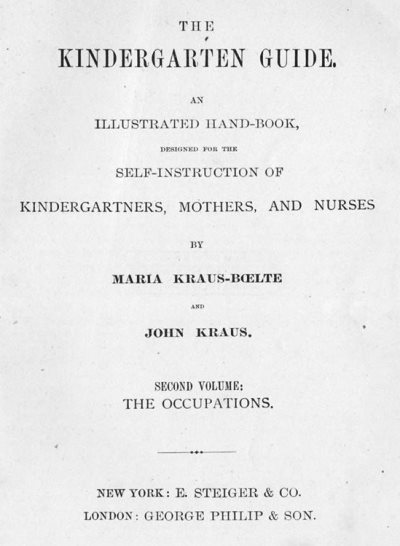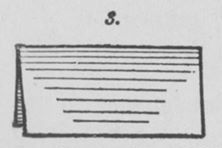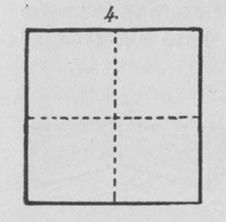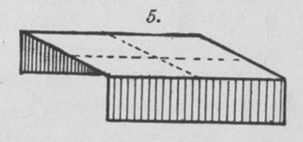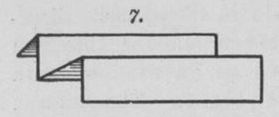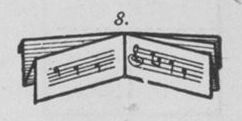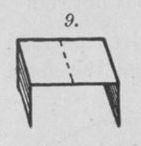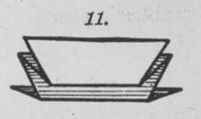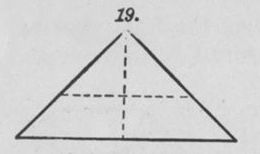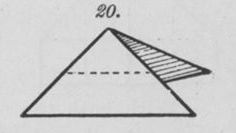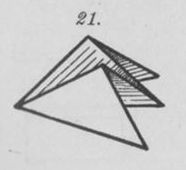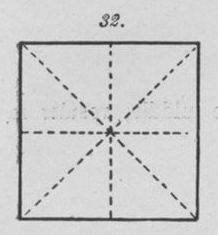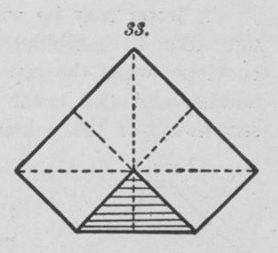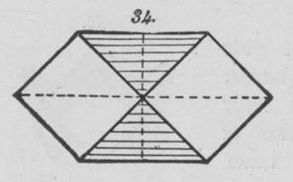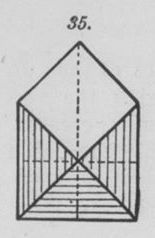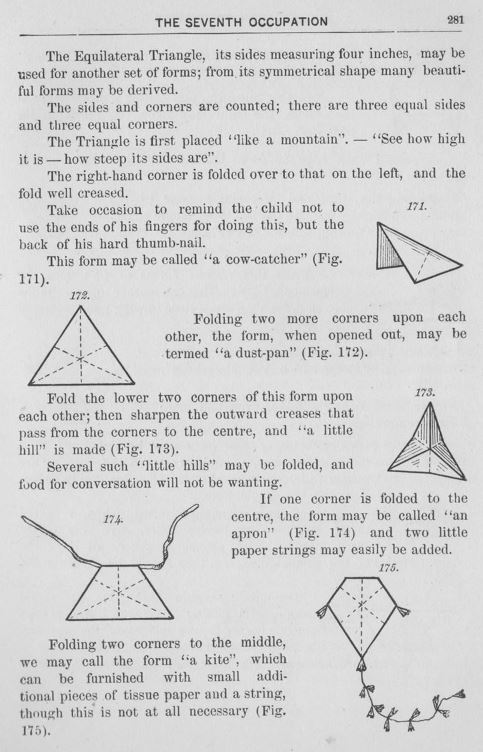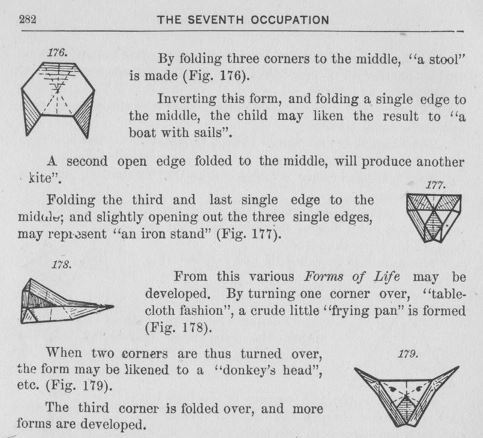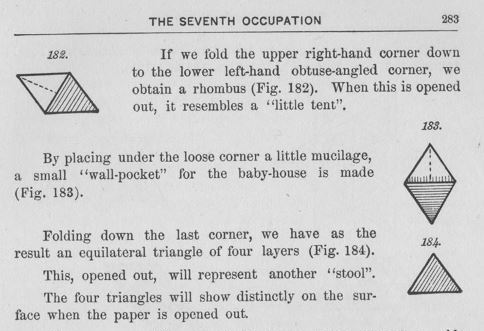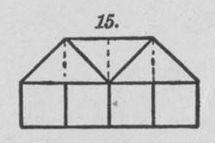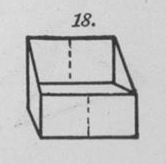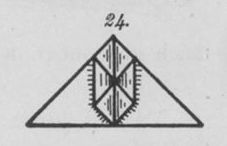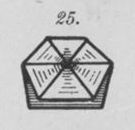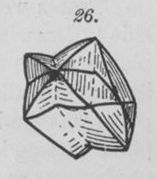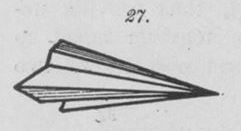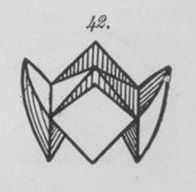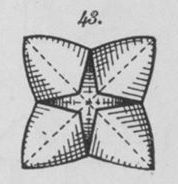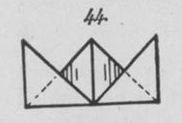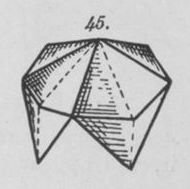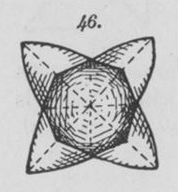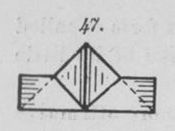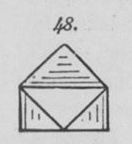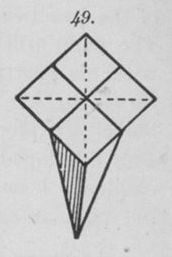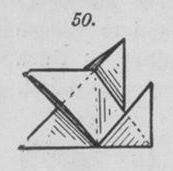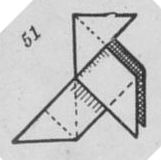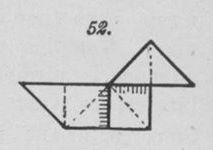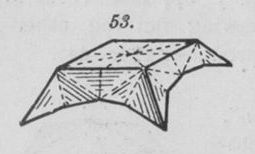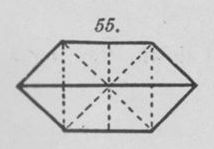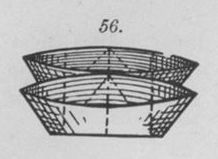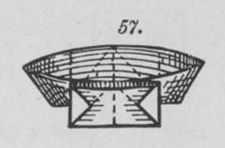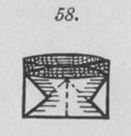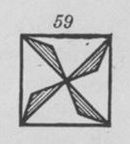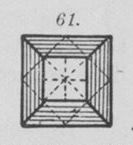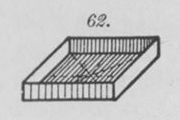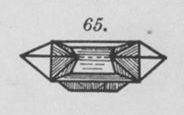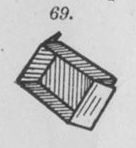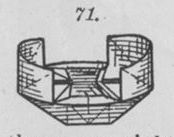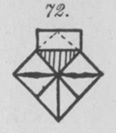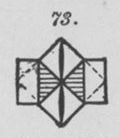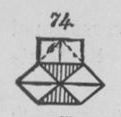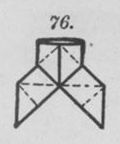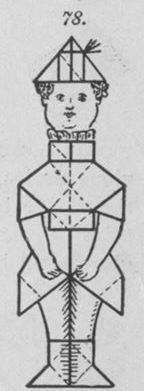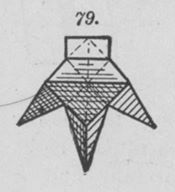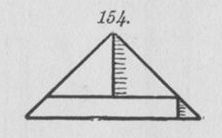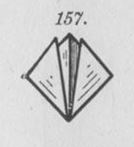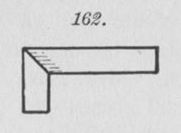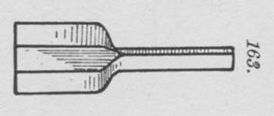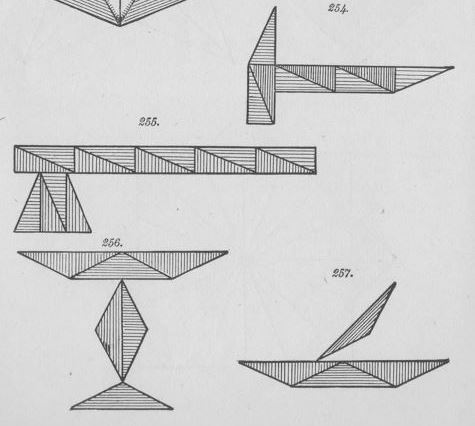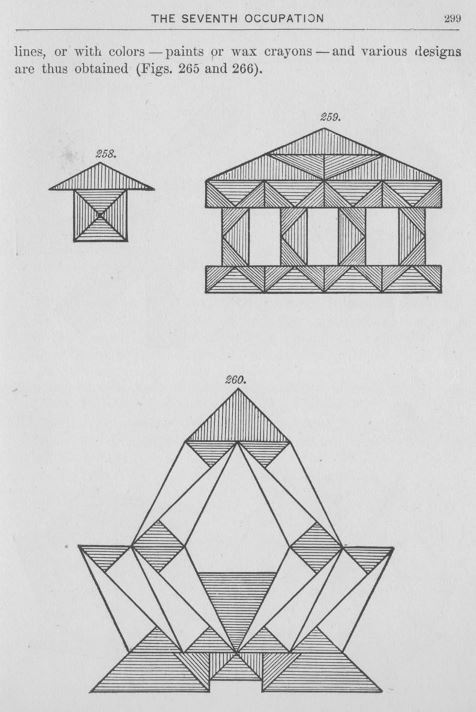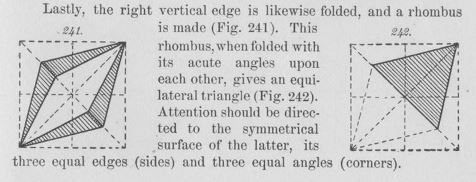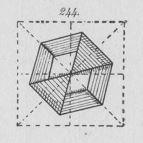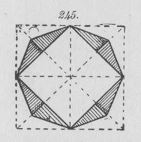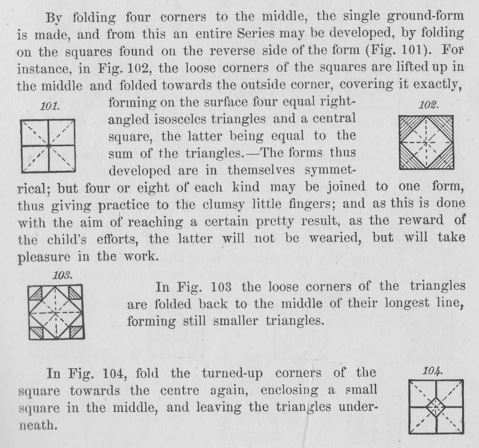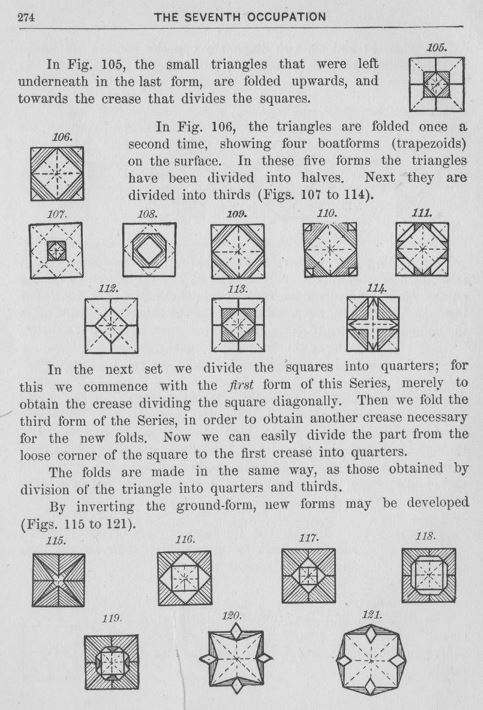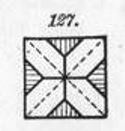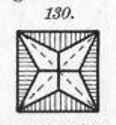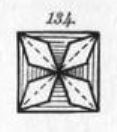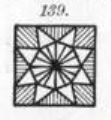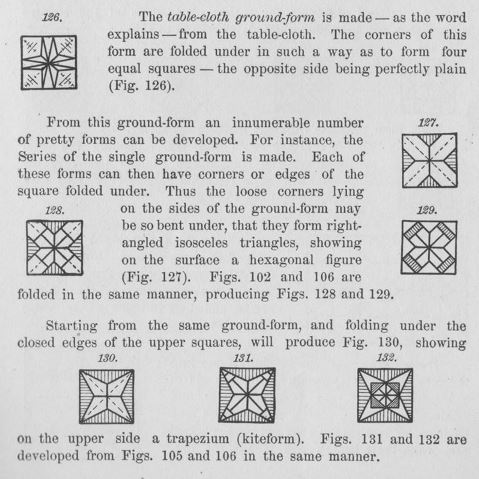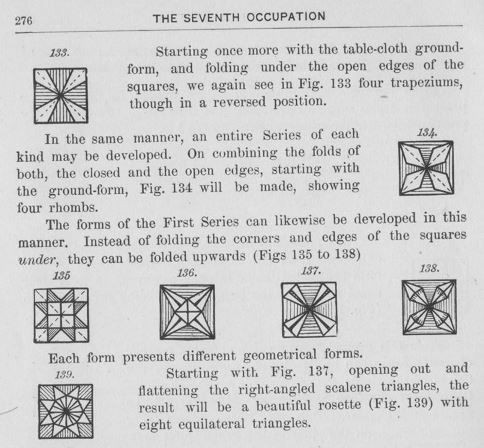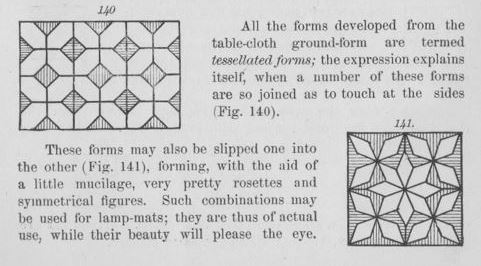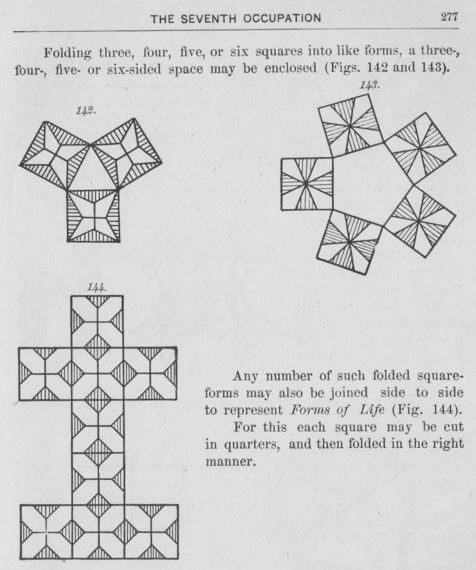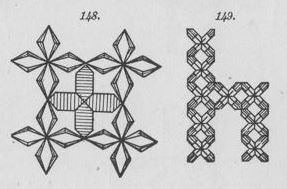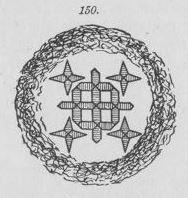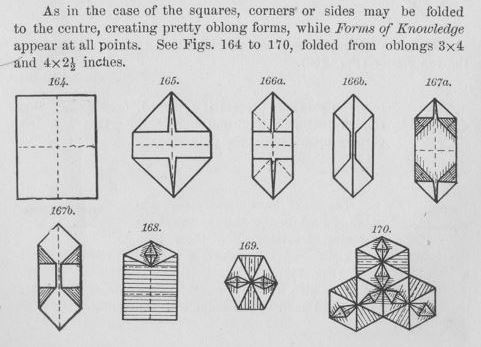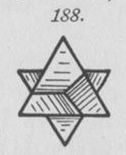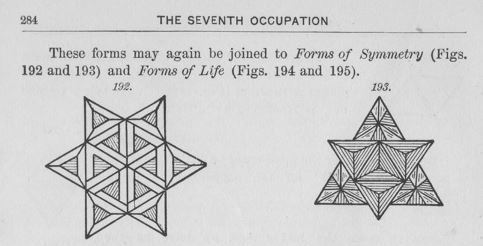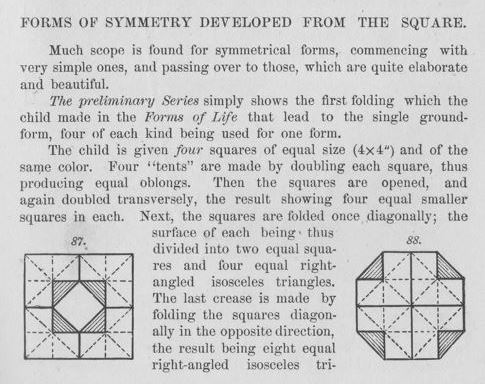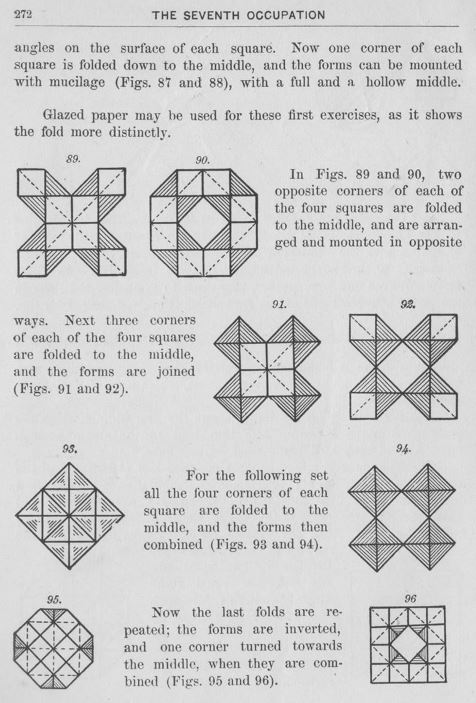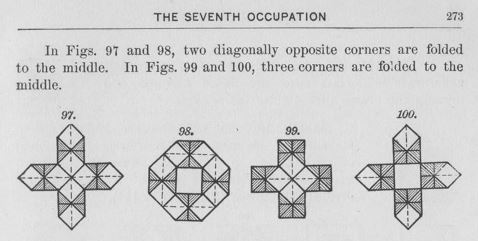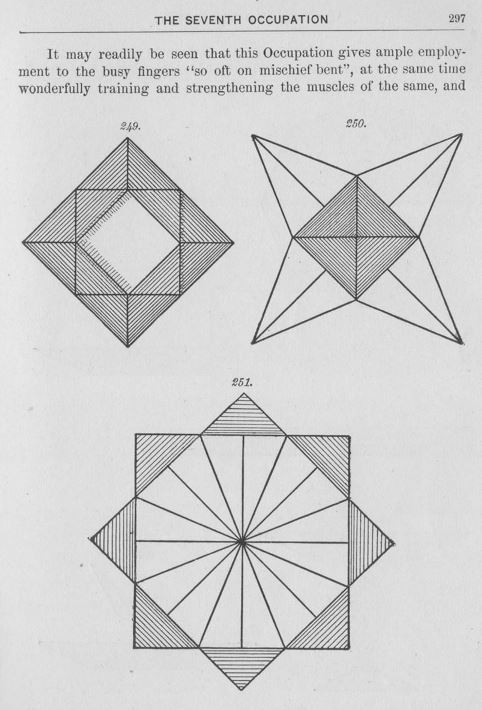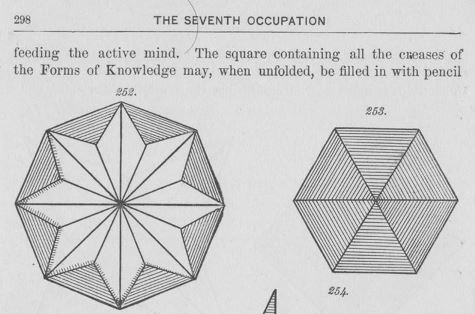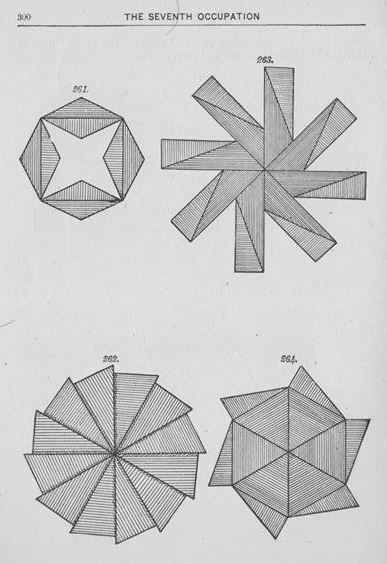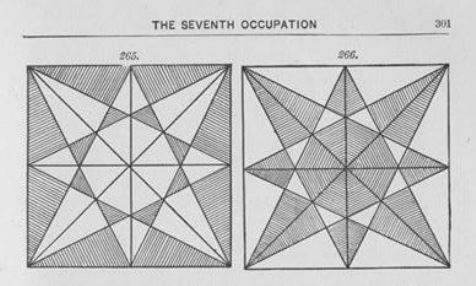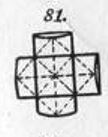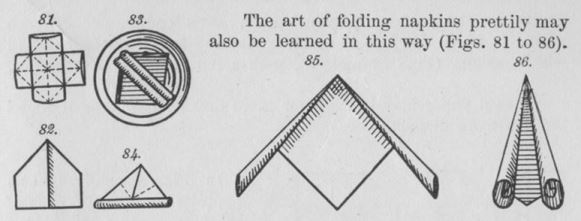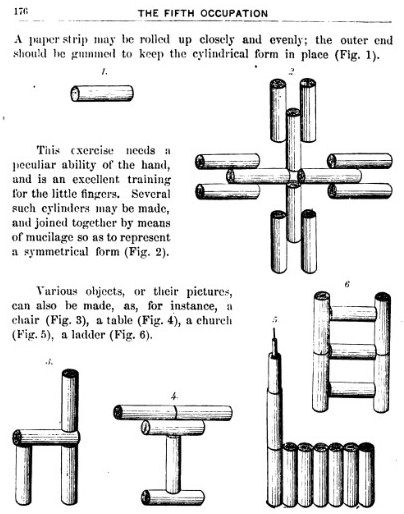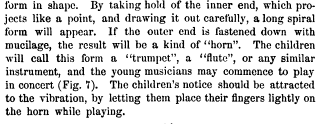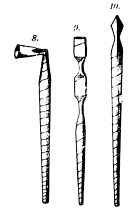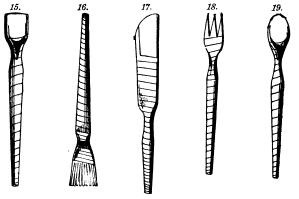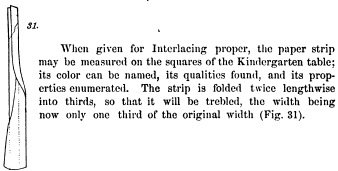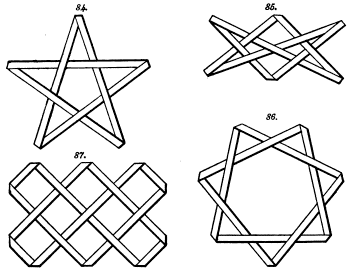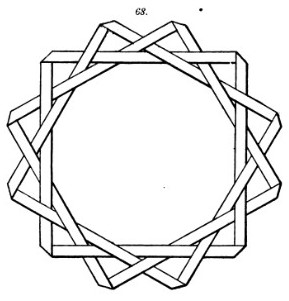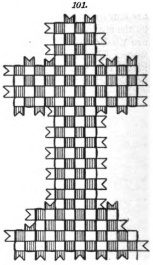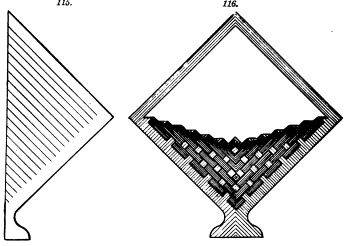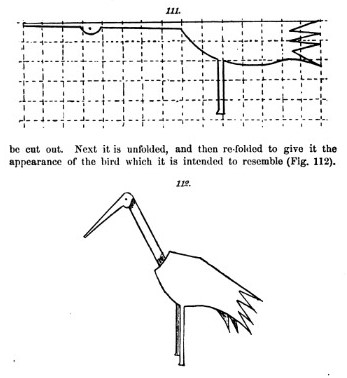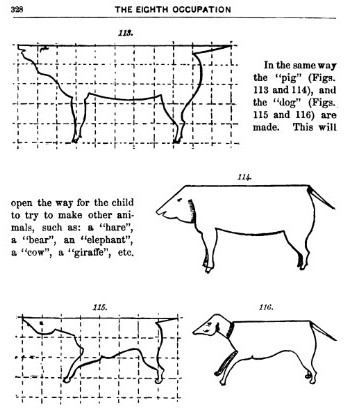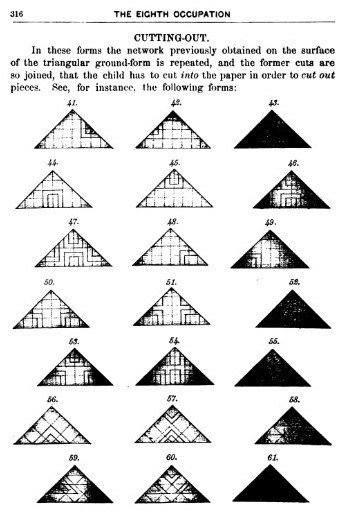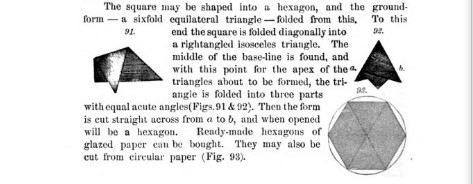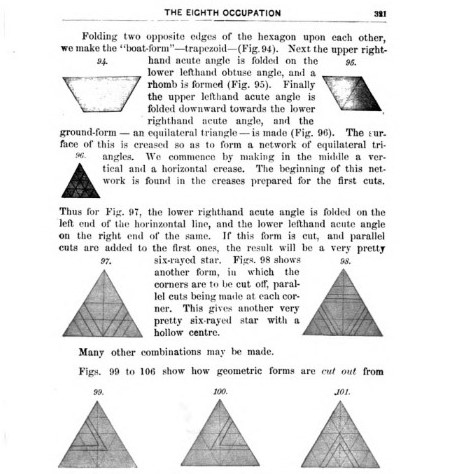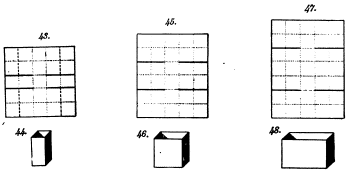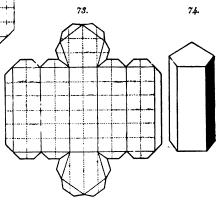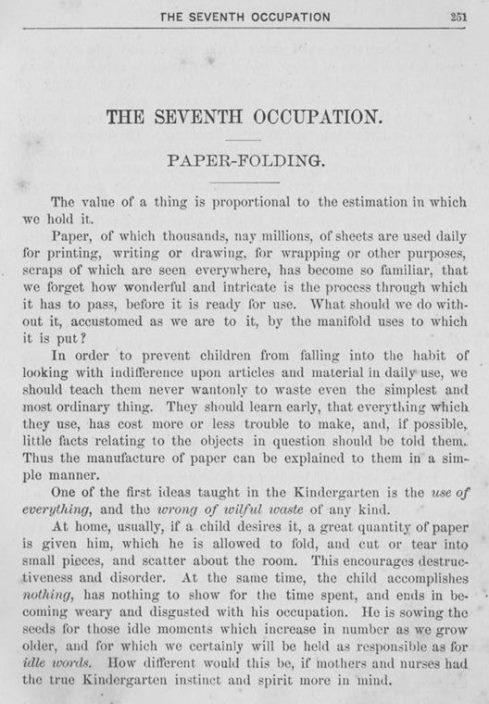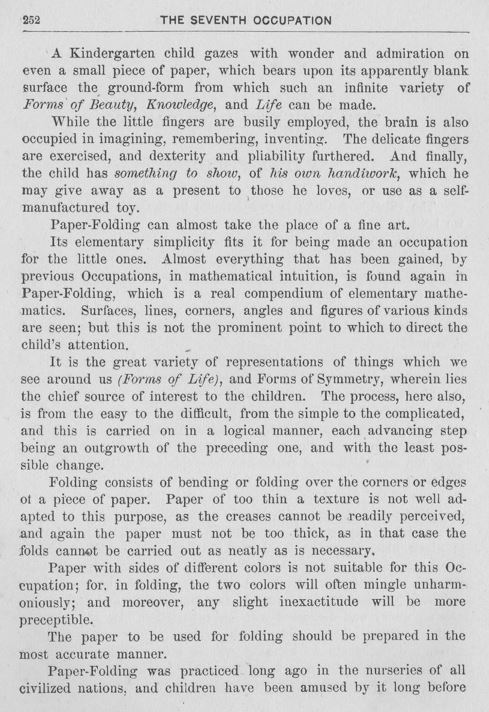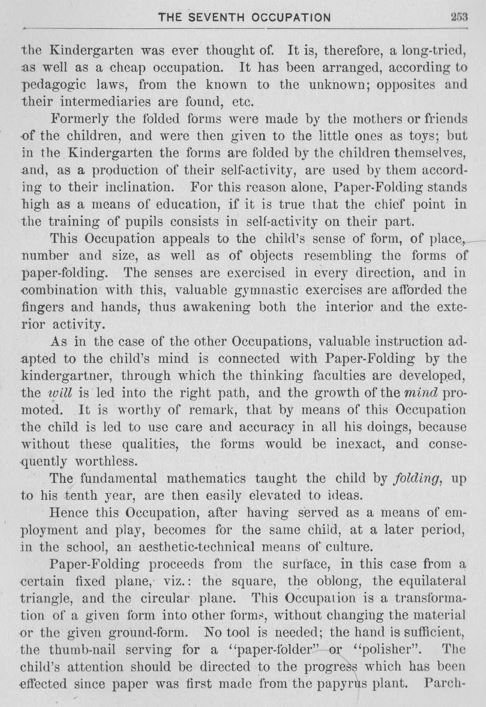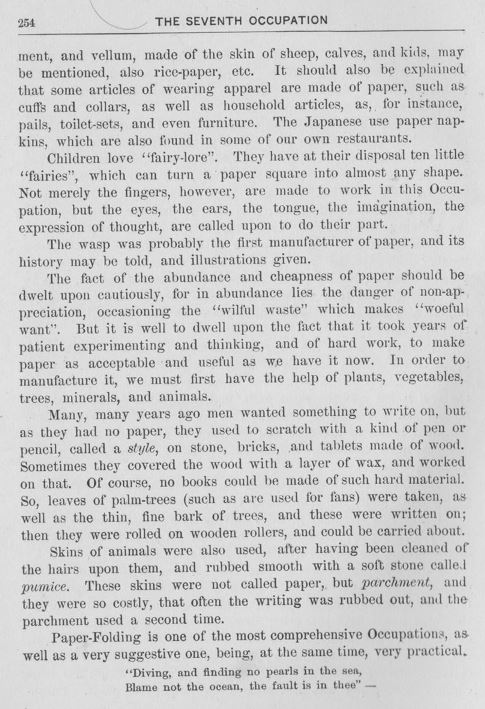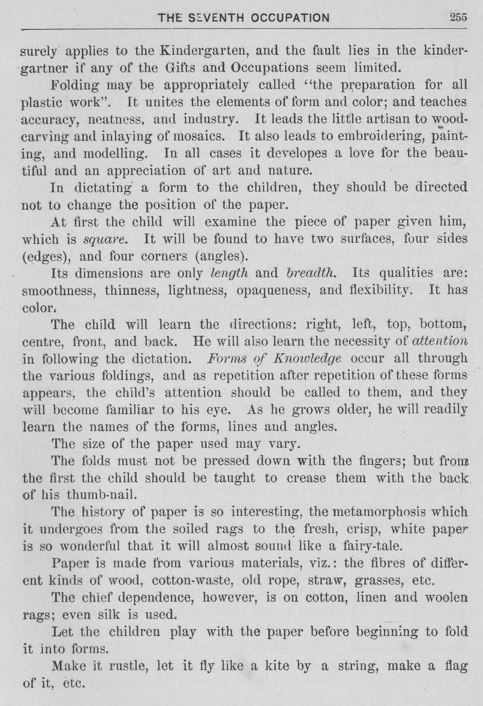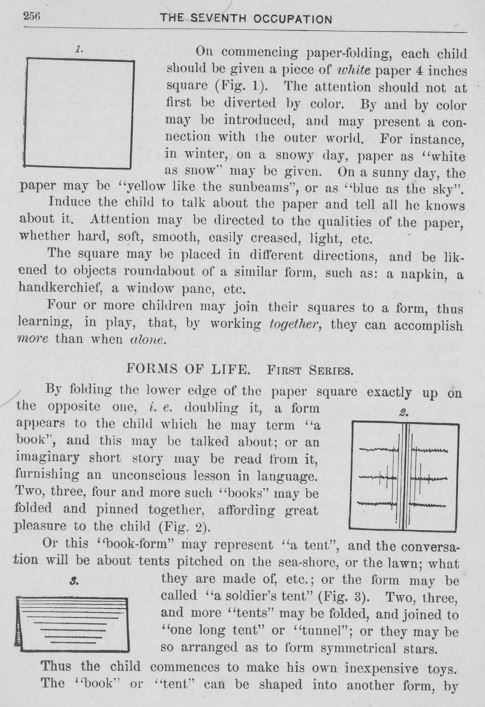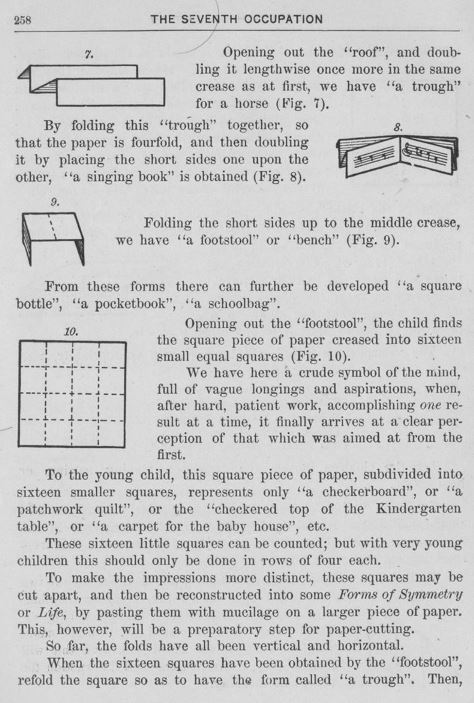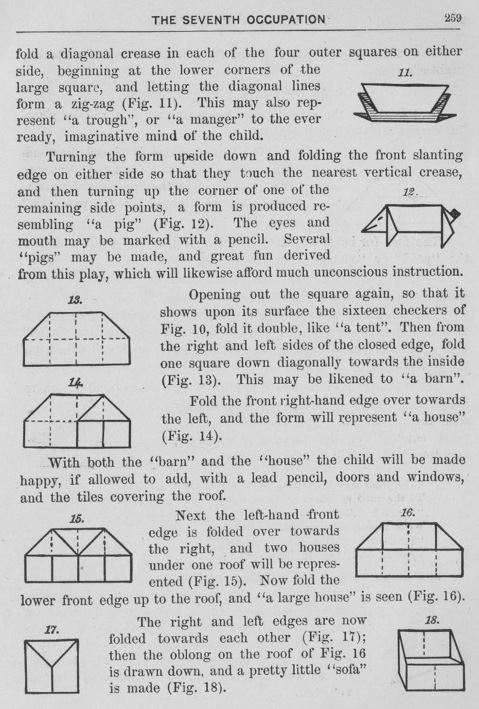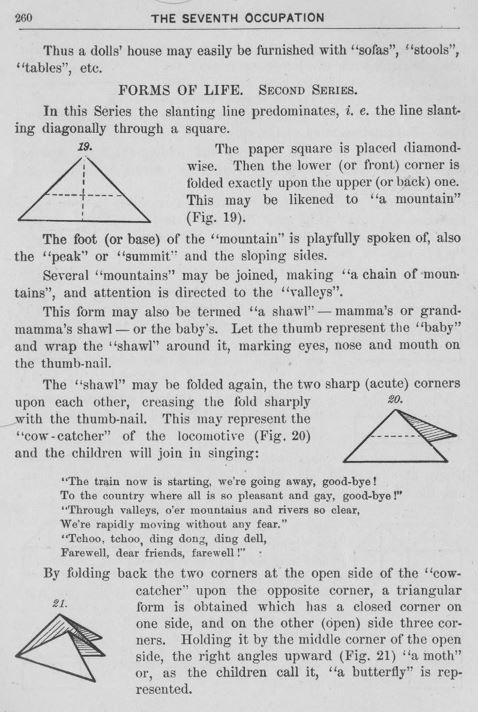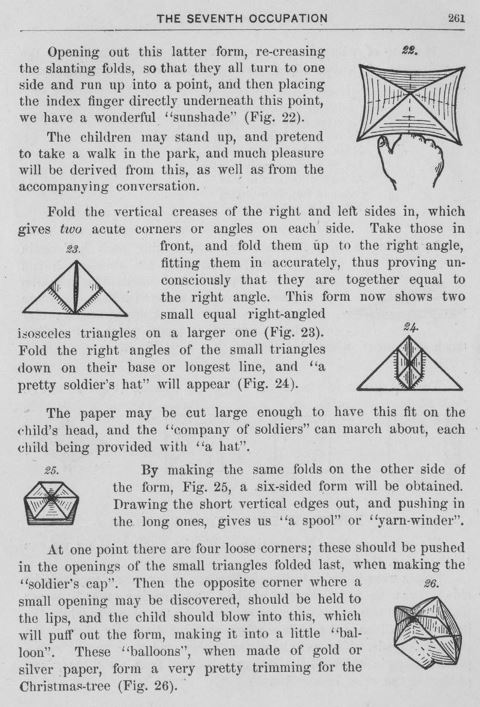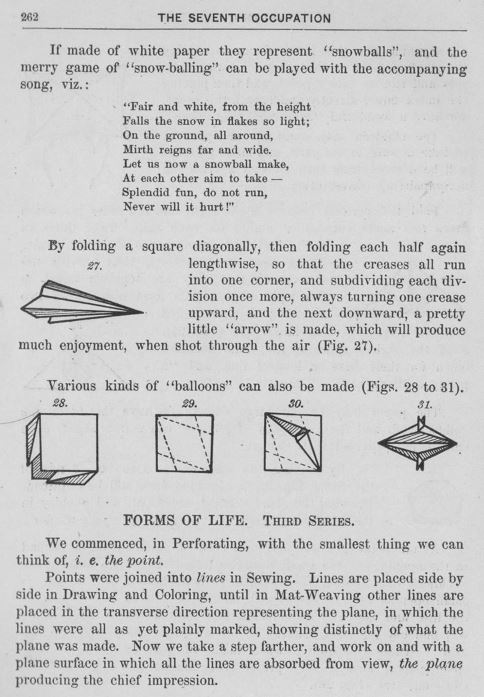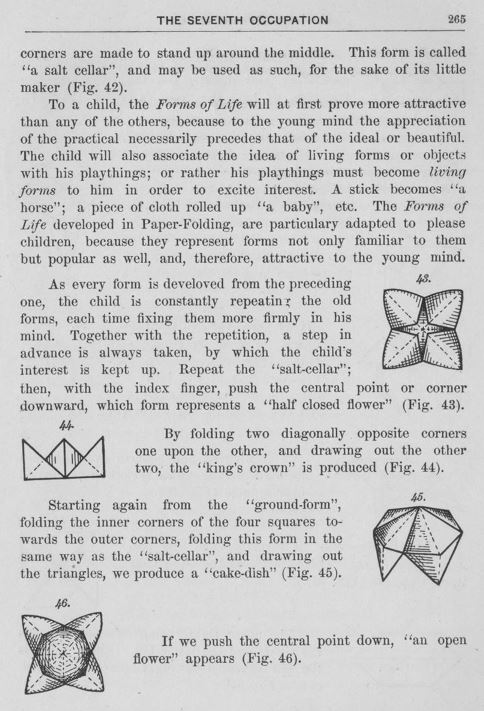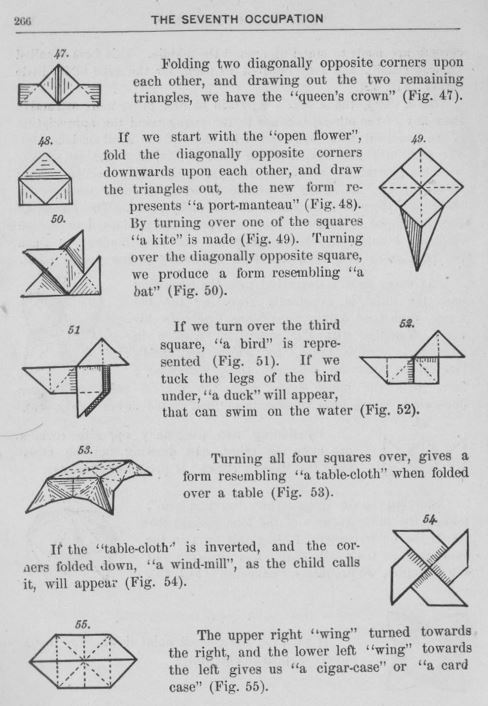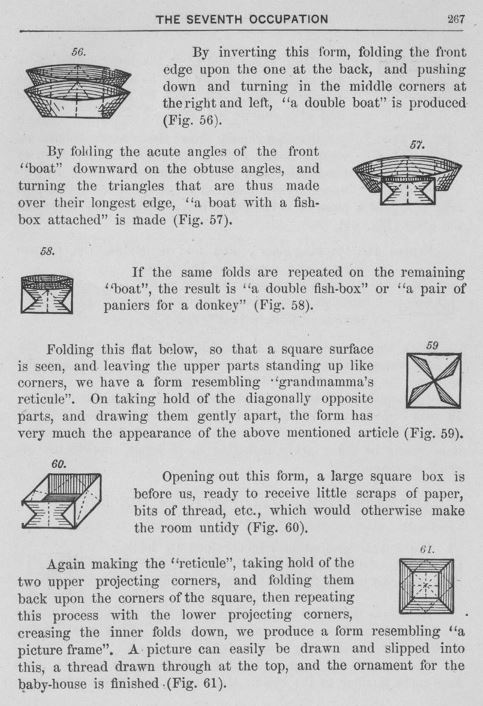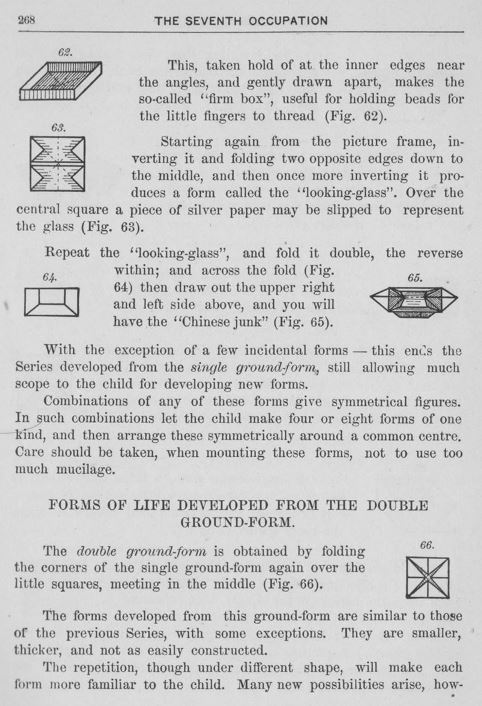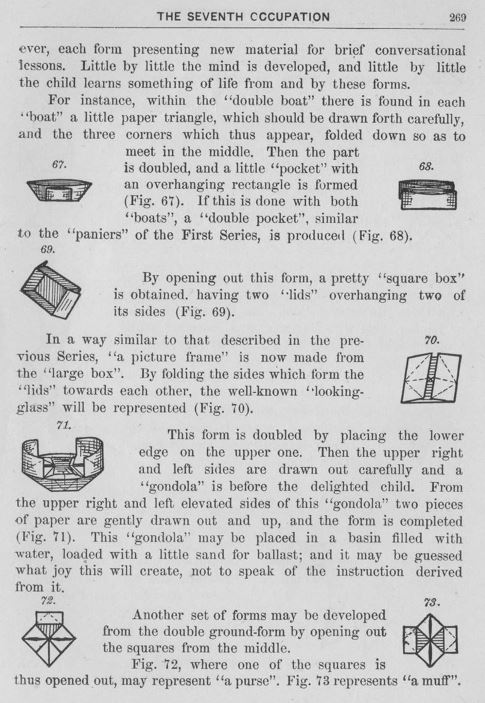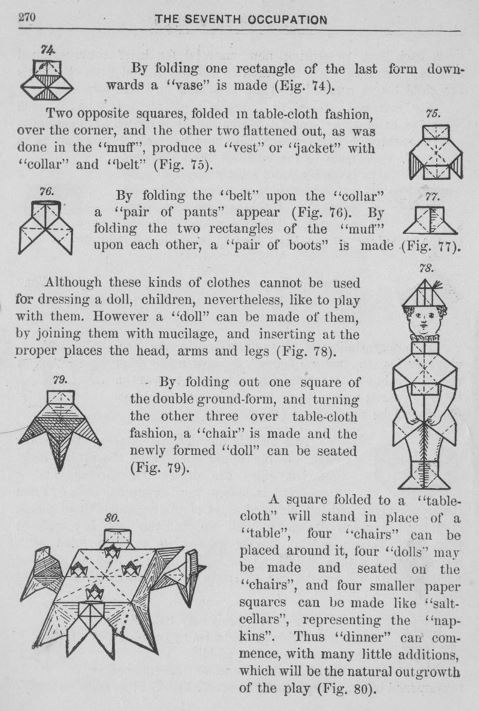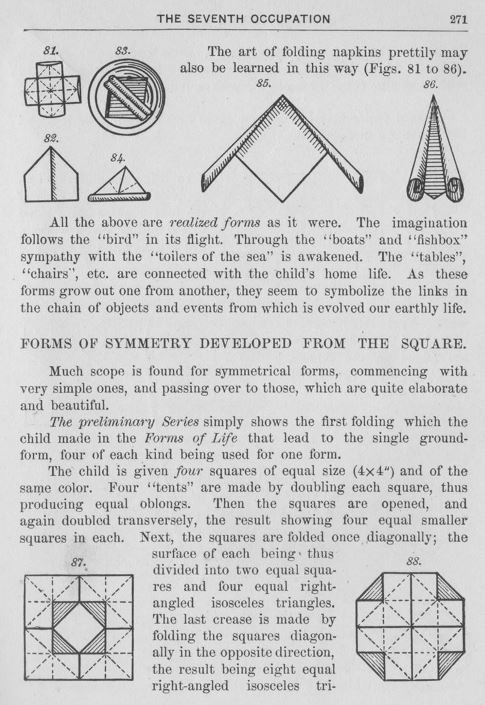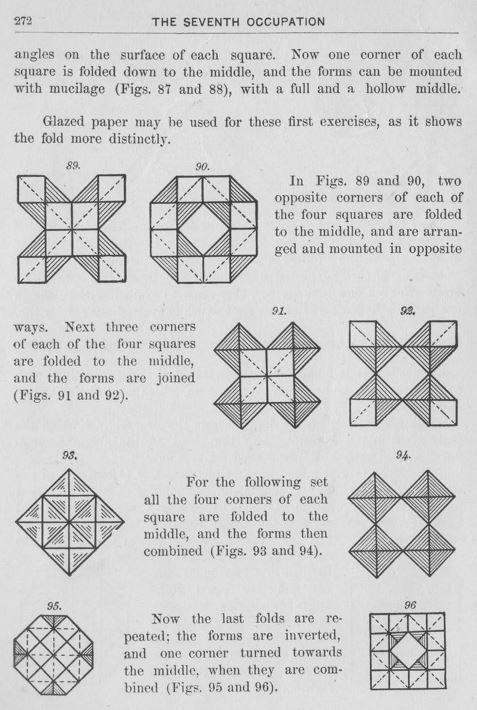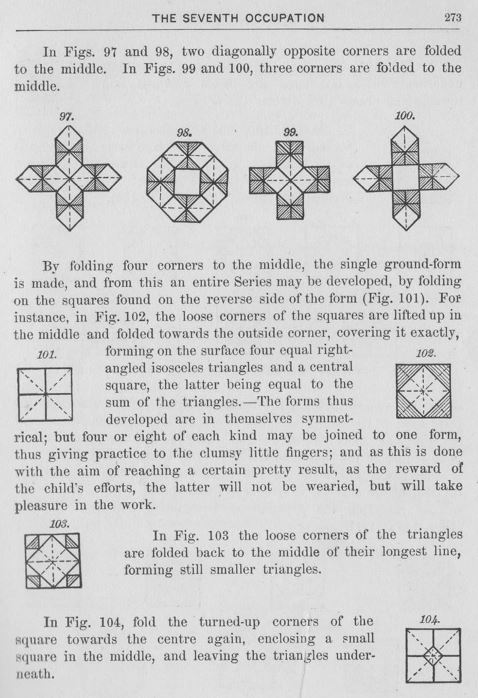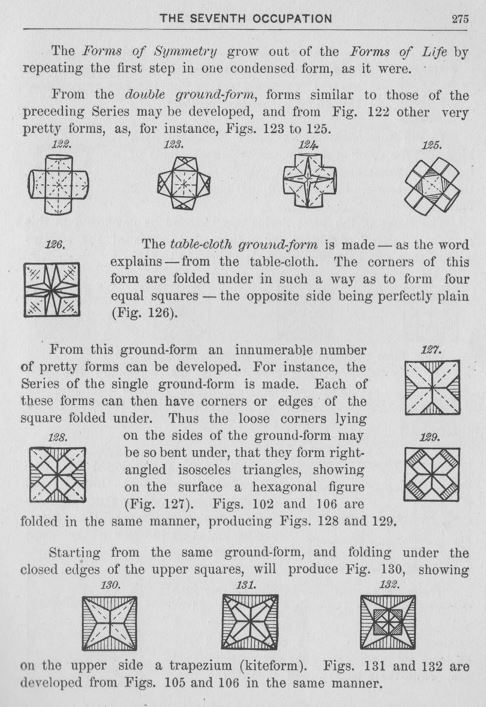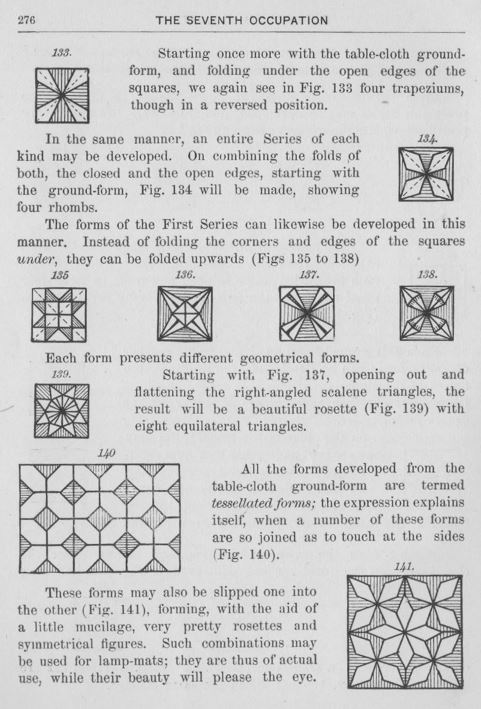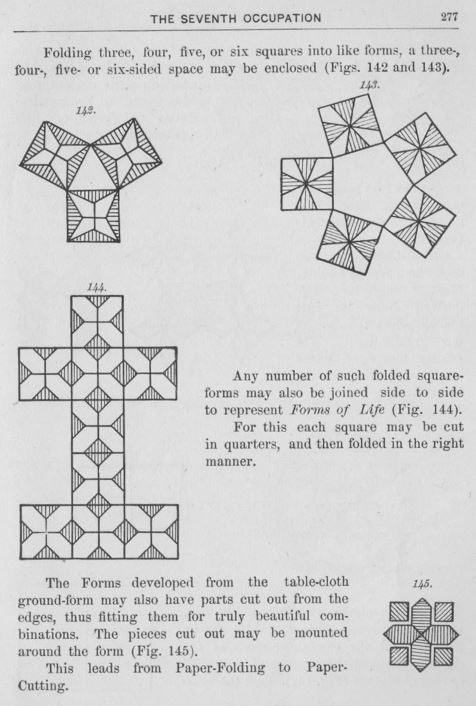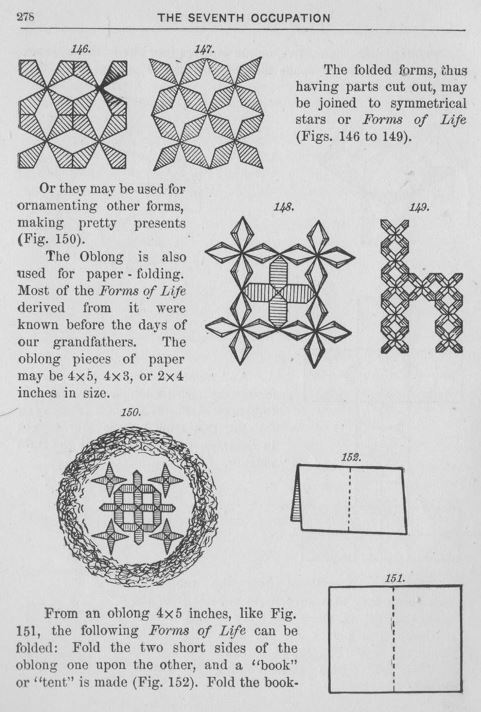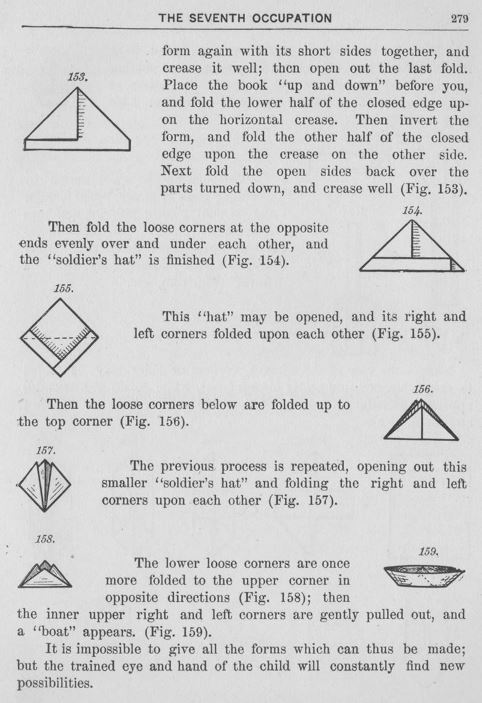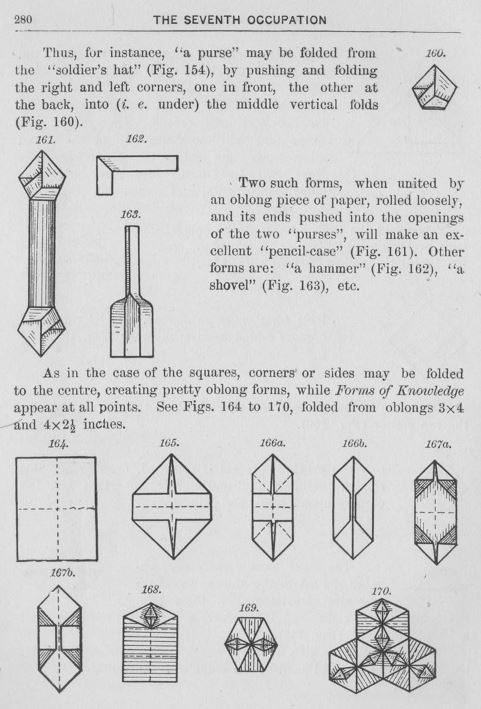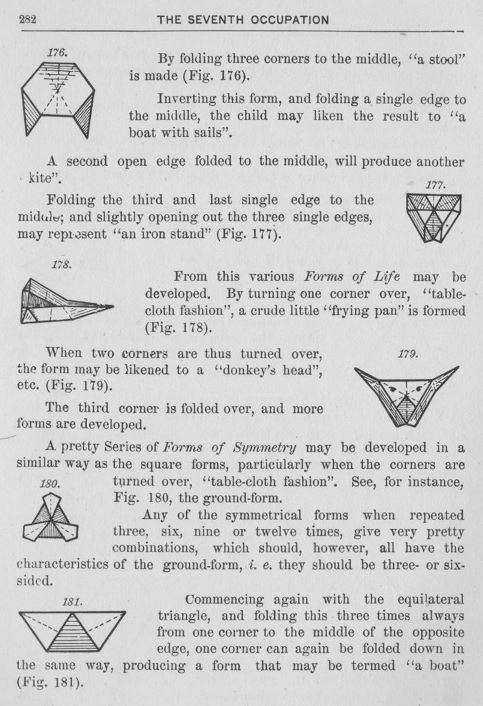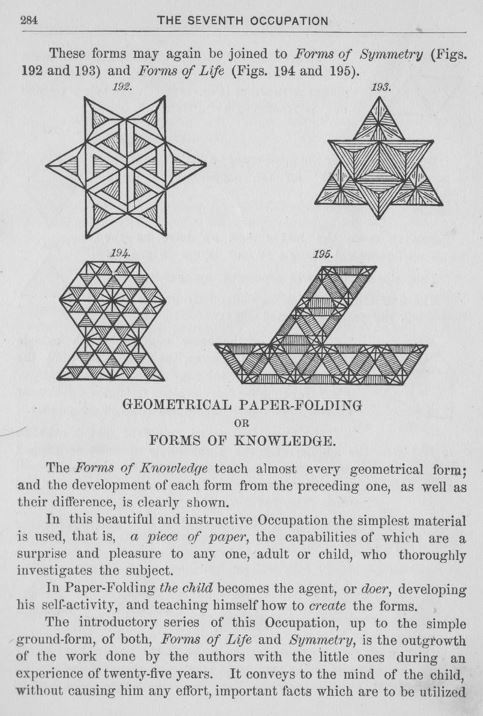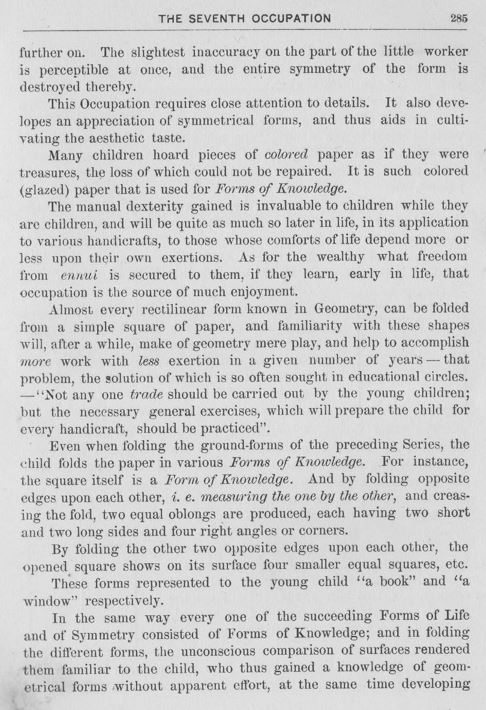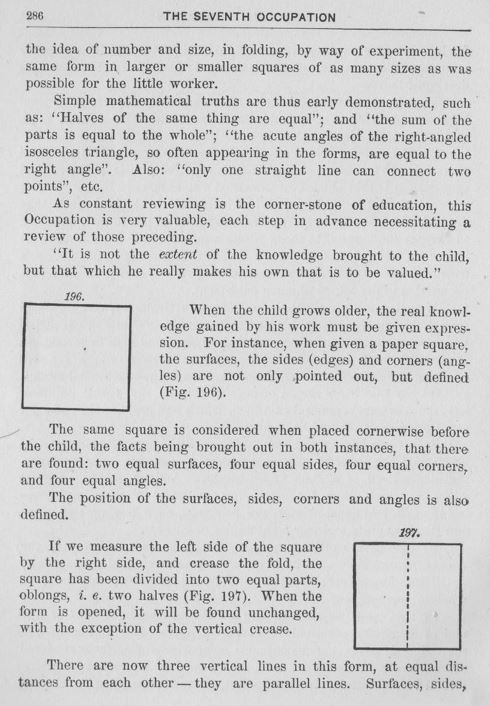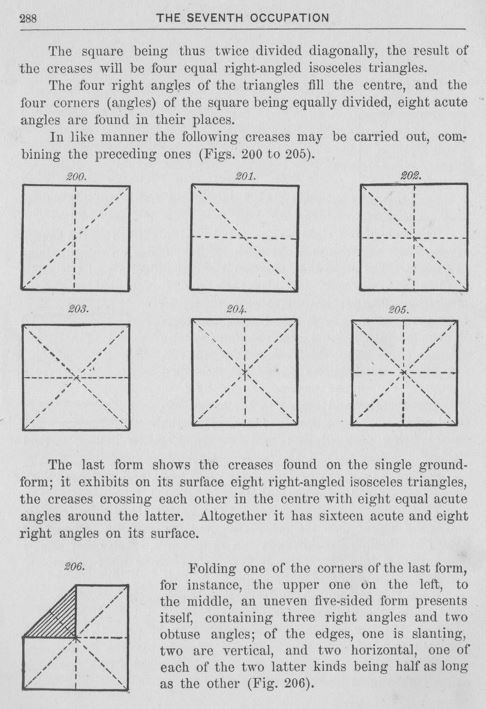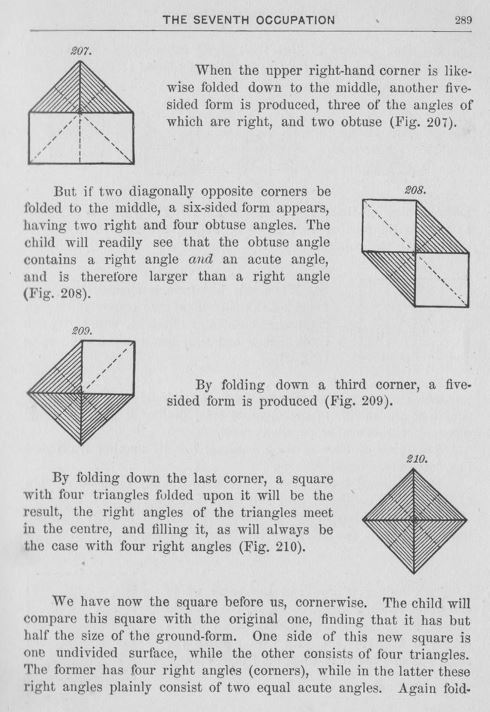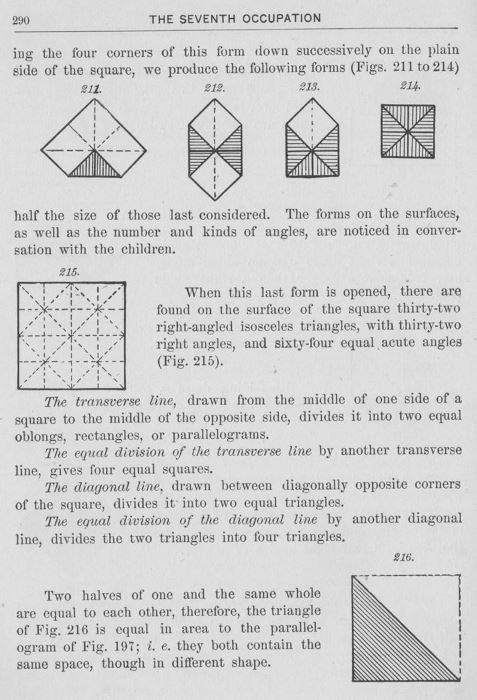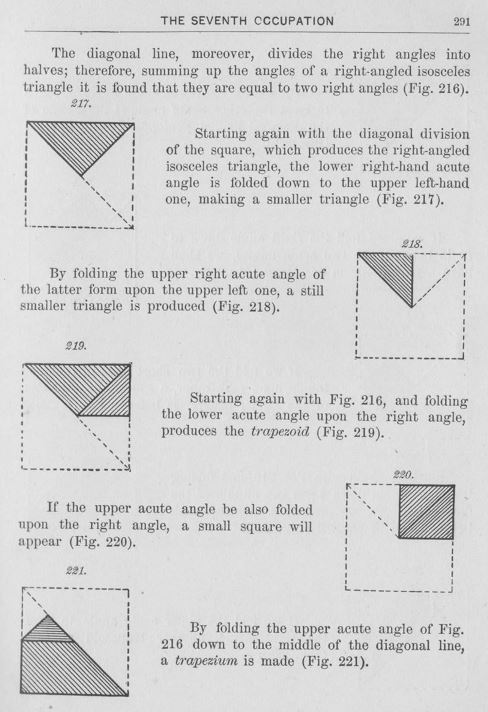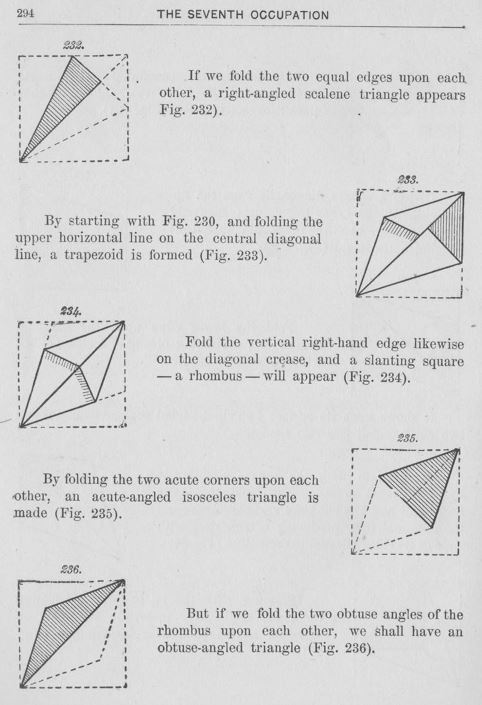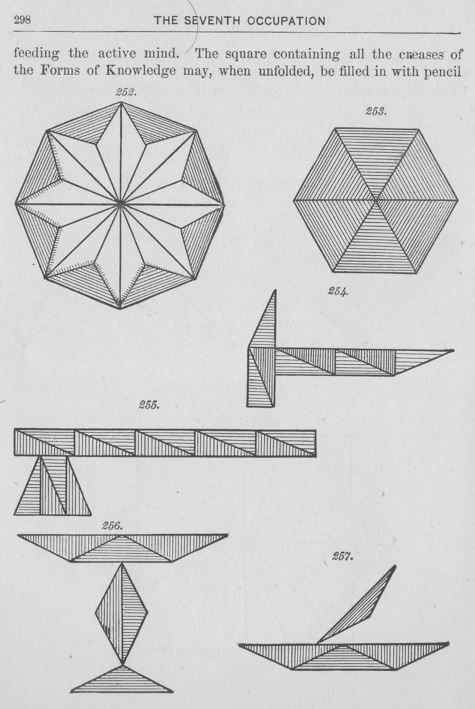| The Public Paperfolding History Project
Last updated 12/11/2025 x |
|||||||
| Part 2 of the Kindergarten Guide by Maria Kraus Boelte and John Kraus | |||||||
| 'The
Kindergarten Guide' by Maria Kraus Boelte and John Kraus
was published by E. Steiger and Company in New York and
by George Philip and Son in London. The material dealing with the gifts was first published in five separate volumes between 1877 and 1880 then consolidated into a single volume, which we now know as Part 1, in 1881. Part 2, dealing with the occupations, is undated but was probably first published in 1882, although individual sections may also have been published earlier. Inter alia Part 2 contains chapters on Paper Folding (Falten), Paper-Interlacing (Verschnuren), Weaving (Flechten), Paper-Cutting and Mounting (Ausschneiden und Aufkleben) and Cardboard Modelling. Illustrations on a grey background are taken from Part 2 of the 1882 first edition, and were kindly provided to me by Joan Sallas. Illustrations on a white background are from Part 2 of the 1892 third edition, a full copy of which can be accessed here. As far as I know there are no substantive differences between the paperfolding content of the first three editions. A full copy of the chapter on Paper Folding (taken from the 1882 edition) can be found at the foot of this page. For full details of the other chapters please see the full text of the 1892 edition. **********
********** Analysis The Seventh Occupation - Paper Folding - Falten This chapter contains a long introduction (included in full at the foot of this page). Inter alia it specifies that:
However, it is not clear if this applies to the folding of Forms of Symmetry made from blintzed, partly blintzed and partly partially blintzed squares, in connection with which the author says:
It should be noted, however, that, this section aside, shading on some areas of a drawing does not necessarily indicate that those sections of the design come from the opposite side of the paper to the areas left unshaded. ********** Material does not necessarily appear in this Analysis in the order in which it appears in the work. This Analysis is divided into the following sections (main section headings emboldened). The titles of these sections are not necessarily taken from the work. Folds of Life: Simple Folds of Life from the Square Simple Folds of Life from the Equilateral Triangle Folds of Life from the Square Folds of Life from Oblongs Folds of life made by combining shapes folded from squares Folds of life made by combining shapes folded from equilateral triangles Folds of Knowledge: Folds of Beauty: Designs from the Double Blintz Basic Form Designs developed from the Cross Designs developed from the Windmill Base Using Forms of Beauty as Tiles - Getafel Formen Cut Forms of Beauty Using Cut Forms of Beauty as Tiles Designs from Oblongs Designs from Equilateral Triangles Folds of Beauty made by combining blintzed, partly blintzed and partly partially blintzed squares Folds of Beauty made by combining other Folds of Knowledge Colouring Crease Patterns: Designs from Napkins: ********** Folds of Life - Lebensformen Designs do not necessarily appear in this Analysis in the same order or under the same headings as they appear in the work. A full copy of the chapter about Paper Folding in its original form is reproduced at the foot of this page. Note that the Double Blintz Basic Form is referred to in this work as 'the single groundform', the Triple Blintz Basic Form as 'the double groundform', and the Windmill Base as 'the table-cloth groundform'. ********** Simple folds of Life from the Square The Book / Tent / Tunnel / Roof (Simply a square of paper folded in half edge to edge)
********** The Window (Simply a square folded in half edge to edge, then unfolded, in both directions.)
********** The Table
********** Trough for a Horse
********** The Singing Book
********** The Footstall or Bench
********** At this point in the work there is a note that this form can be further developed into a Square Bottle, a Pocketbook and a Schoolbag, but there are no accompanying illustrations to show what these forms look like. ********** The Trough or Manger (A preparatory design for the pig.)
********** The Mountain (Simple a square folded diagonally in half.)
********** The Shawl (not illustrated) ********** The Cow Catcher
********** The Moth or Butterfly
********** The Sunshade
********** The Union Jack
********** The Boat
********** The Flag
********** An Open Envelope (The open flap of which can be closed to create a letter.)
********** Simple Folds of Life from the Equilateral Triangle
********** Folds of Life from the Square The Pig
********** The House
********** The Sofa
********** The Soldier's Cap
********** The Spool or Yarn Winder
*********** The Balloon or Snowball (The Waterbomb)
********** The Arrow (The Paper Dart)
********** The Bellows (Illustrated, but not named, with the comment 'Various kinds of 'balloons' can also be made.')
********** Designs from the Single Groundform The Salt Cellar
********** The Half Closed Flower (The Seedpod)
********** The King's Crown
********** The Cake Dish (The Pepperpot)
********** The Open Flower (The Open Seedpod)
********** The Queen's Crown
********** The Portmanteau (The Travel Bag)
********** The Kite
********** The Bat
********** The Bird (The Cocotte or Pajarita)
********** The Duck
********** The Tablecloth
********** The Windmill
********** The Cigar Case or Card Case
********** The Double Boat
********** The Boat with Fishbox (Note that in this version the ends of the front hull have been folded up in preparation for folding the Closed Box.)
********** The Double Fishbox or Pair of Panniers for a Donkey (The Portfolio) (Note that in this version the ends of both hulls have been folded up in preparation for folding the Open Box.)
********** Grandmamma's Reticule
********** The Large, Square Box (The Open Box)
********** The Picture Frame
********** The Firm Box (The Solid Box)
********** The Looking Glass (The Mirror)
********** The Chinese Junk (The Gondola)
********** Designs from the Double Groundform: The Square Box Having Two 'Lids' (The Junk Box) (Note that this design is produced from a double boat folded from a blintzed windmill base. One flap is pulled out and folded to produce a 'little pocket with an overhanging rectangle' and the other flap pulled out and folded similarly to produce 'a double pocket similar to the 'paniers' of the First Series'. The box is made by flattening out this form.
********** The Gondola (The Chinese Junk) (The Chinese Junk is then developed in the normal way via the blintz windmill base versions of the picture frame and the mirror.)
********** The Cross (and some decorative variations)
********** The Purse (The Scent Bottle)
********** The Muff
********** The Vase
********** The Vest (The Jacket)
********** The Pair of Pants (The Trousers)
********** The Pair of Boots
********** The Doll (composed of various folded and non-folded parts glued together)
********** The Chair
********** Folds of Life from Oblongs In the work this section is introduced with the comment 'The oblong is also used for paper-folding. Most of the Forms of Life derived from it were known before the days of our grandfathers.' The Soldier's Hat - The Newspaper Hat (an unusual variation made by folding one flap forwards and the other backwards)
********** A smaller Soldier's Hat - The Pyramidal Hat
********** The Paper Boat (made in an unnecessarily complicated way by folding up the corners of the Pyramidal Hat rather than just opening the hat out)
********** A Purse - The Mitre
********** The Pencil Case
********** A Hammer - The Hammer
********** A Shovel - The Shovel
********** Folds of Life made by combining shapes folded from squares
********** Folds of Life made by combining shapes folded from equilateral triangles
********** Folds of Knowledge Pages 284 to 296 specifically explain how to develop Forms of Knowledge from squares. However there are also references to other Forms of Knowledge (whether named as such or not) made from squares, oblongs and equilateral triangles throughout the chapter. Many of these forms are given the names of common objects and so also treated as Forms of Life. Those forms of knowledge worthy of separate note are: How to Construct a Diamond and an Equilateral Triangle
********** Constructing a Regular hexagon
********** Constructing a Regular Octagon
********** Folds of Beauty - Schonnheitsforman Designs from the Double Blintz Basic Form
********** Designs developed from The Cross
********** Designs developed from the Windmill Base (called the table-cloth ground-form here) The Diagonal Cross
********** Four Points
********** Four Kites
********** Four Rhombi
********** The Sunburst
**********
********** Using Forms of Beauty as Tiles - Combinations
********** Cut Forms of Beauty
********** Using Cut Forms of Beauty as Tiles
********** Designs from Oblongs (including compound forms)
********** Designs from Equilateral Triangles (including compound forms) The Forms of Beauty in this section include the Interwoven Star of David
**********
********** Folds of Beauty made by combining blintzed, partly blintzed and partly partially blintzed squares
********** Folds of Beauty made by combining other Folds of Knowledge
********** Colouring Crease Patterns
********** Designs from Napkins Note that The Cross was not included among the Folds of Life. None of these Napkin folds are given names.
**********
********** The Fifth Occupation: Paper-Interlacing This chapter not only includes Paper-Interlacing proper but also other activities which make use of long strips of paper. For full details see the full text of the 1892 edition. Designs made from rolls of paper Shapes made by gluing together paper cylinders
********** The Butterchurn
********** The Horn - The Newspaper Sword
********** Other designs made by squashing similar drawn out spirals
********** Designs made from paper strips Fairy Steps (The Witches' Ladder)
********** Stars - The Paper Rosette
********** Paper Interlacing - Verschnuren Strips of paper are folded into thirds to increase their strength and are used either singly or in combinations of two or three strips to create wide variety of geometrical forms. For full details of these forms see full text of the 1892 edition.
********** The Sixth Occupation: Weaving This chapter includes material on weaving with folded strips and how to make fold and cut chevron designs. Those designs particularly worth noting are shown below. For other designs refer to the full text of the 1892 edition. ********** Free Weaving Designs The Woven Cross
********** Fold and Cut Chevron Designs Bookmark
********** Fold and Cut Chevron Basket
********** The Eighth Occupation: Paper-Cutting and Mounting This chapter not only includes Paper-Cutting and Mounting proper but also other activities which depend on cutting. For full details see the full text of the 1892 edition. Rings (Paper Chains)
********** Windmill (The Cut and Fold Windmill)
********** Fold, Cut and Fold Animals
********** Paper-Cutting and Mounting - Ausschneiden und Aufkleben This section shows how to fold a square into an eight-layer right angle isosceles triangle which is then cut into in various predetermined ways. All the pieces are then opened out and mounted to create patterns.
The same thing can by starting with the Fold and One Cut Hexagon then folding it into a six-layer equilateral triangle.
The text also mentions the possibility of doing the same thing with circles. For full details see the full text of the 1892 version. ********** The Tenth Occupation: Cardboard Modelling Here are just a few examples of the types of cardboard modelling explained in this chapter. For further details reference should be made to the full text of the 1892 edition. Slit and Fold Boxes
********** Crystals (Cut and Fold Polyhedra) Nets for various prisms and pyramids, all the Platonic solids, a truncated square-based pyramid, a cone and a cylinder.
********** Forms of Life (produced by combining cut and fold geometric forms)
********** Cut and Fold Furniture
********** Selected Pages
********** |
|||||||
